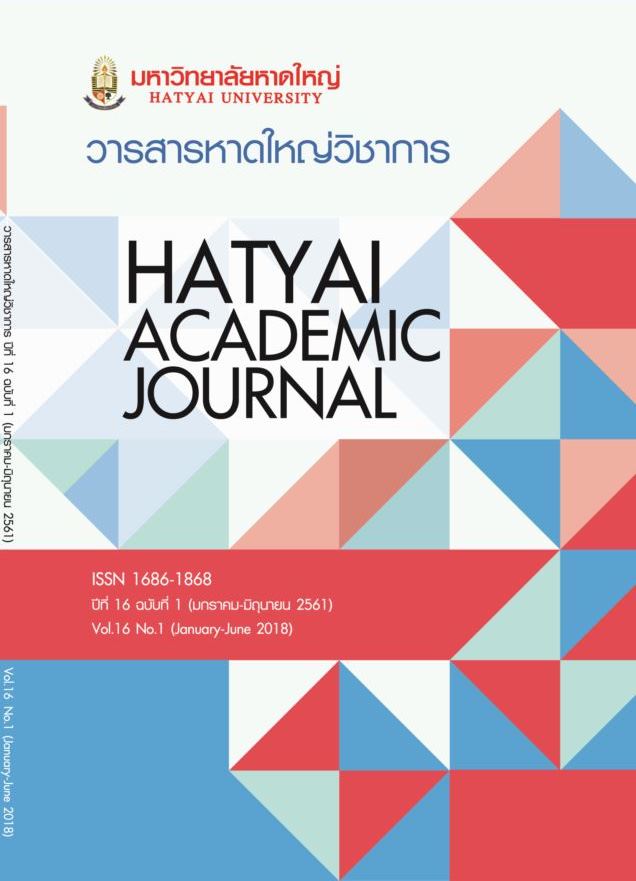ปัจจัยจำแนกความคงทนในการตัดสินใจศึกษาต่ออาชีวศึกษา
Main Article Content
Abstract
This research aims to investigate factors that discriminate student’s retention of decision-making to study in vocational education institutions. A random sample was taken of 342 potential students willing to study at the institutions. Only 233 students retained the decision and those 109 students changed their decision to study in basic education institutions. Two variables of demographic factors, nine variables of situational factors and psychological traits factors, and five variables of psychological states factors were used to classify the different groups of students. Hierarchical Multiple Logistic Regression was applied to the data analysis and Bootstrap Resampling Techniques was used for validating the results. The results
showed that the factors that discriminate the retention of decision-making with a statistical significance level at 0.05 and consistent classification are different types of institutions and students’ attitudes toward the value of vocational education. It is also found that the retention can be discriminated by students’ perception of decision- making self-efficacy on continuing their study in vocational education institutions, parent’s expectations, guides from teachers, and lack of information; however, the discrimination is not consistent.
บทคัดย่อ
การวิจัยครั้งนี้มีวัตถุประสงค์เพื่อค้นหาปัจจัยที่สามารถจำแนกกลุ่มนักเรียนที่มีความคงทนในการตัดสินใจ
ศึกษาต่ออาชีวศึกษา กลุ่มตัวอย่างเป็นนักเรียนจำนวน 342 คน ที่ตั้งใจศึกษาต่ออาชีวศึกษา เมื่อตัดสินใจศึกษาต่อ แล้วแบ่งเป็นนักเรียนที่มีความคงทนในการตัดสินใจศึกษาต่ออาชีวศึกษา 233 คน และนักเรียนที่เปลี่ยนการตัดสินใจ ศึกษาต่อในสายสามัญ 109 คน ปัจจัยที่ใช้จำแนกได้แก่ ปัจจัยควบคุมเป็นปัจจัยด้านประชากร 2 ตัวแปร ปัจจัย สถานการณ์และจิตลักษณะเดิม 9 ตัวแปร ปัจจัยจิตลักษณะตามสถานการณ์ 5 ตัวแปร ใช้การวิเคราะห์ถดถอย โลจิสติกแบบตามลำดับขั้น และทดสอบความคงที่ของผลการวิจัยโดยการสุ่มซ้ำด้วยการวิเคราะห์บูทสแตรปในการวิเคราะห์ข้อมูล ผลการวิจัยพบว่า ตัวแปรที่สามารถจำแนกความคงทนในการตัดสินใจศึกษาต่ออาชีวศึกษาของนักเรียนได้อย่างมีนัยสำคัญทางสถิติที่ระดับ 0.05 และมีความคงที่ในการจำแนก ได้แก่ สังกัดของโรงเรียนที่นักเรียนศึกษา และเจตคติต่อการศึกษาต่ออาชีวศึกษาด้านการเห็นคุณค่า ส่วนการรับรู้ความสามารถของตนต่อการตัดสินใจ ศึกษาต่ออาชีวศึกษา การรับรู้ความคาดหวังของผู้ปกครอง การรับรู้การแนะแนวจากครู และการขาดสารสนเทศ พบว่าสามารถจำแนกความคงทนในการศึกษาต่ออาชีวศึกษาได้ แต่ขาดความคงที่ในการจำแนก
Article Details
All published articles are evaluated by three qualified peer reviewers from various institutions through a double-blind process, where reviewers do not know the authors’ identities and authors do not know the reviewers’ identities. The content and articles in the Hatyai Academic Journal reflect the authors’ views only and are neither the opinions of the editorial board nor the responsibility of Hatyai University. The Editorial Board of the Hatyai Academic Journal allows articles to be reproduced for academic purposes, on the condition that the original source is clearly cited.
References
จิราภรณ์ ภู่เทศ และ บารมี บุญทรง. (2555). ค่านิยมเกี่ยวกับการศึกษาของไทย: กรณีศึกษาจากสำนวนไทยและข่าวหนังสือพิมพ์. สักทอง: วารสารมนุษยศาสตร์และสังคมศาสตร์, 18(1), 91-109.
ดวงเดือน พันธุมนาวิน. (2541). รูปแบบปฏิสัมพันธ์นิยม (Interactionism Model) เพื่อการวิจัยสาเหตุของพฤติกรรมและการพัฒนาพฤติกรรมมนุษย์. วารสารทันตาภิบาล, 10(2), 105-108
ดุจเดือน พันธุมนาวิน. (2550). รูปแบบทฤษฎีปฏิสัมพันธ์นิยม (Interactionism model) และแนวทางการตั้งสมมติฐาน ในการวิจัยสาขาจิตพฤติกรรมศาสตร์ในประเทศไทย. วารสารพัฒนาสังคม, 9(1), 85-117.
ทัศนา ทองภักดี, อรพินทร์ ชูชม, และ อัจฉรา สุขารมณ์. (2551). ความสัมพันธ์ระหว่างภูมิหลังของนักเรียน ผลสัมฤทธิ์ทางการเรียน บุคลิกภาพ ค่านิยมในอาชีพ กับการเลือกอาชีพของนักเรียนขั้นมัธยมศึกษาปีที่ 3. รายงานวิจัยฉบับที่ 113 สถาบันวิจัยพฤติกรรมศาสตร์ มหาวิทยาลัยศรีนครินทรวิโรฒ.
ธนากร พงษ์เผือก. (2549). สาเหตุการไม่เลือกศึกษาต่อในสายอาชีวศึกษาของนักเรียนระดับมัธยมศึกษาตอนปลายชั้นปีที่ 4 ของโรงเรียนในเขตพื้นที่การศึกษากรุงเทพมหานคร (วิทยานิพนธ์มหาบัณฑิต). สถาบันเทคโนโลยีพระจอมเกล้าพระนครเหนือ, กรุงเทพฯ.
เรวดี วัฒฑกโกศล. (2533). การสำรวจความเชื่อ เจตคติ เจตนา และพฤติกรรมการเลือกศึกษาต่อสามัญหรือสายอาชีพของนักเรียนชั้นมัธยมศึกษาปีที่ 3 ในกรุงเทพมหานคร ตามแนวทฤษฎีการกระทำด้วยเหตุผล (วิทยานิพนธ์มหาบัณฑิต). จุฬาลงกรณ์มหาวิทยาลัย, กรุงเทพฯ.
วรรณี แกมเกตุ. (2536). ความสัมพันธ์เชิงสาเหตุของตัวแปรที่มีอิทธิพลต่อการเลือกสถานศึกษาสำหรับบุตรของผู้ปกครองนักเรียนชั้นมัธยมศึกษาตอนต้นในภาคกลาง: การวิเคราะห์เส้นทาง (วิทยานิพนธ์มหาบัณฑิต). จุฬาลงกรณ์มหาวิทยาลัย, กรุงเทพฯ.
วัลภา สบายยิ่ง. (2541). ปัจจัยในการตั้งเป้าหมาย การรับรู้ความสามารถของตนเองและบุคลิกภาพที่ส่งผลต่อการปฏิบัติงานของผู้จำหน่ายตรง (ปริญญานิพนธ์ดุษฎีบัณฑิต). มหาวิทยาลัยศรีนครินทรวิโรฒ, กรุงเทพฯ.
สำนักงานคณะกรรมการการอาชีวศึกษา. (2560). แผนพัฒนาการอาชีวศึกษา 2560-2579. กรุงเทพฯ: สำนักงานคณะกรรมการการอาชีวศึกษา.
สำนักงานเลขาธิการสภาการศึกษาแห่งชาติ. (2553). การศึกษาความต้องการกำลังคนเพื่อวางแผนการผลิตและพัฒนากำลังคนของประเทศ. กรงเทพฯ: สกศ.
หนังสือพิมพ์แนวหน้า. (25 กันยายน 2556). ค่านิยมของผู้ปกครองและนักเรียนไม่นิยมศึกษาต่อระดับอาชีวศึกษา. หนังสือพิมพ์แนวหน้า. หน้า 5.
วันฉัตร ทิพย์มาศ. (2556). ปัจจัยที่มีอิทธิพลต่อการตัดสินใจเข้าศึกษาต่อวิทยาลัยอาชีวศึกษาเอกชนของนักเรียน ในเขตภาคใต้ตอนบน. วารสารศึกษาศาสตร์ มหาวิทยาลัยบูรพา, 24(2), 150-160.
อธิปัตย์ คลี่สุนทร. (2557). การวางแผนและการศึกษาผลกระทบต่อสิ่งแวดล้อมทางธรรมชาติ. Rajabhat Journal of Sciences, Humanities & Social Science, 15(1), 21-31.
Albion, M. J., & Fogarty, G. J. (2002). Factors influencing career decision making in adolescents and adults. Journal of Career Assessment, 10(1), 91-126.
Bandura, A. (1977). Social learning theory. Englewood Cliffs, NJ: Prentice-Hall.
Bandura, A. (1997). Self-efficacy: The exercise of control. New York: Freeman.
Betz, N. E., Klein, K. L., & Taylor, K. M. (1996). Evaluation of a short-form of career decision making self-efficacy scale. Journal of Career Assessment, 4(1), 47-57.
Costa, P. T., & McCrae, R. R. (1995). Revised NEO personality inventory (NEO PI-R) and NEO five-factor inventory (NEO FFI). Florida: Psychology Assessment Resource.
Fishbein, M., & Ajzen, I. (1975). Belief, attitude, intention, and behavior: An introduction to theory and research. Reading MA: Addison-Wesley.
Fishbein, M., & Ajzen, I. (2010). Predicting and changing behavior: The reasoned action approach. New York: Psychology Press.
Gati, I., & Saka, N. (2001). High school students’ career-related decision-making difficulties. Journal of Counseling & Development, 79, 331-340.
Gati, I., & Tal, S. (2008). Decision making models and career guidance. . In J. Athanasou, & R. V. Esbroeck (Eds), International Handbook of Career Guidance (pp. 157-185). Springer.
Gati, I., Krausz, M., & Osipow, S. H. (1996). A taxonomy of difficulties in career decision making. Journal of counseling Psychology, 43(4), 510-526.
Guay, F., Senecal, C., Gauthier, L., & Fernet, C. (2003). Predicting career indecision: A self-determination theory perspective. Journal of Counseling Psychology, 50(2), 165-177.
Ibrahim, R., Aloka, P. J. O., Wambiya, P. & Raburu, P. (2014). Perceptions on the role n secondary school students’ career decision making. Journal of Educational and Social Research, 4(6), 313-323.
Jaccard, J., Turrisi, J., & Wan, C. K. (2003). Interaction Effects in Multiple Regression (2nd ed.). Beverly Hills, CA: Sage.
Kenny, D. A. (1998). Multiple latent variable models: Confirmatory factor analysis. Retrieved from www.davidkenny.net/cm/mfactor.htm
Lent, R. W. (2005). A social cognitive view of career development and counseling. In S. D. Brown & R. W. Lent (Eds.), Career development and counseling: Putting theory and research to work (pp. 101-127). New York: Wiley.
Lent, R. W., Brown, S. D., & Hackett, G. (2002). Social cognitive caeer theory. In D. Brown (Ed.), Career choice and development (pp. 255-311). San Francisco: Jossey-Bass.
Marcionetti, J. (2014). Factors affecting teenagers’ career indecision in southern Switzerland. Procedia-Social and Behavioral Sciences, 112, 158-166.
Muthen, L. K., & Muthen, B. O. (2007). Mplus user’s guide. (5th ed.). Los Angeles, CA: Muthen & Muthen.
Osborne, J. W. (2015). Best practices in logistic regression. Los Angeles, CA: Sage.
Peduzzi, P., Concato, J., Kemper, E., Holford, T. R., & Feinstein, A. R., (1996). A simulation study of the number of events per variable in logistic regression analysis. Journal of Clinical Epidemiology, 49, 1373-1379.
Turner, S. L., Alliman-Brissett, A., Lapan, R. T., Udipi, S., & Ergun, D. (2003). The career-related parent support scale. Measurement and Evaluation in Counseling and Development, 36, 83-94.
Wentzel, K. R. (1998). Parents’ aspirations for children’s educational attainments: Relational to parental belief’s and social address variables. Merril-Palmer Quarterly, 44: 20-37.
Zimet, G. D., Dahlem, N. W., Zimet, S. G., & Farley, G. K. (1988). The multidimensional scale of perceived social support. Journal of Personality Assessment, 52(1), 30-41.

